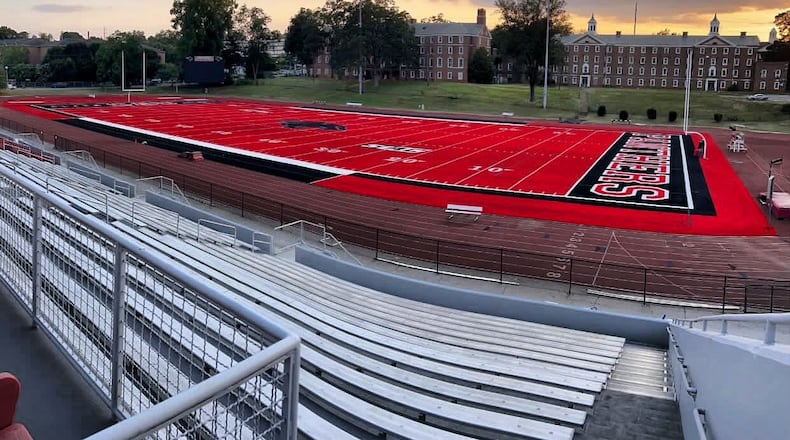Football games at a couple of Black colleges around Georgia are about to get more colorful this season.
The Arthur M. Blank Family Foundation has supplied $6.5 million worth of grants to four Southern historically Black colleges and universities to refurbish their football fields.
Clark Atlanta University took the refurbishment idea to the next level, while hearkening back to its storied past.
When CAU kicks off the season against Allen University on Sept. 7 at Panther Stadium, they will run onto a bright red football field with the image of a giant black Panther emblazoned on the 50-yard line.
Yes. Red.
“When you look at Clark Atlanta University, we are the red carpet of the Atlanta University Center,” said CAU’s athletic director Jerel Drew. “We wanted to make a bold statement.”
Not to be outdone, Albany State University has converted its natural grass football and soccer field to a new dark blue turf.
“The new turf installation will have a lasting impact on our community’s health and wellness,” said Kristen Kelly, ASU’s athletic director. “It provides a safe, state-of-the-art space for youth programs, local sports leagues and fitness events.”
Credit: Albany State University
Credit: Albany State University
According to the Arthur M. Blank Family Foundation, the HBCU Invitational Field Refurbishment Program is designed to improve field quality, safety and accessibility for students and local community groups serving youth through football.
The program is funded by the Blank Family Foundation and supported by the NFL Foundation.
The Blank Family Foundation’s donation, particularly to CAU, continues a recent set of gifts the Atlanta-based philanthropic organization has made to Black colleges in the city.
Last December, the foundation committed $3 million to enhance, digitize and market Morris Brown College’s hospitality certificate program. The gift represented the largest grant the Atlanta school — which had been struggling after losing accreditation more than two decades ago — had gotten in more than 20 years.
This new round of grants for the football programs was open to HBCUs in Georgia and Alabama.
Savannah State University and Miles College in Fairfield, Alabama, were also awarded grants for their football facilities.
“The positive impact of athletics is a driving force throughout our portfolio of businesses,” said AMB Sports and Entertainment CEO Rich McKay. “Arthur Blank and his Family Foundation recognize and prioritize community impact through sport, and supporting these historical institutions is a natural extension of our values.”
Highlighted by Boise State University’s blue field, known as “The Blue,” non-green football turfs have slowly become a growing trend among football programs looking to boost attention.
In 2022, Livingstone College, a tiny Division II school in Salisbury, North Carolina, became the first HBCU to infuse color when it debuted its light blue turf.
CAU is only the second school in the nation to adopt the red color for its turf, following Eastern Washington University, which installed “The Inferno” in 2010.
Drew said the idea of going red — CAU’s colors are black and red — dates back nearly a century.
In 1928, Clark College’s most storied football team went undefeated. That team was called “The Black Battalion.”
Credit: Clark Atlanta University
Credit: Clark Atlanta University
“That team is revered because they shed blood, sweat and tears,” Drew said. “And over the years, a lot of people have shed blood, sweat and tears on that field.”
Drew said the football players are quickly getting used to the red surface of Panther Stadium, located in the center of the campus.
With a new field, a new coach and a host of new players, the Panthers are trying to rebound from an 0-10 season.
“Players are adapting to it and excited to be on it,” Drew said. “It is flashy and new and with this generation of student-athletes, it is all about the flash. It is a big boost of confidence.”
About the Author
Keep Reading
The Latest
Featured






